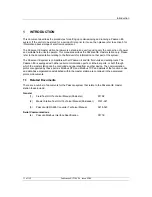
Jumpers and Links
25 of 132
Publication S177E V2.0 Issue 12/04
J8 – CTS Function Select for Port 2
Link 2-3 (default setting) causes the master station to ignore the RS232 CTS line on Port 2. If the link
is placed in 1-2, then the connected serial device may control the output of the master station on Port
2. This may be required if Port 2 is operating a printer.
J17 and J18 – RS485 Termination
These allow for two terminating 100 ohm resistors to be connected to the RS485 lines to prevent
signal reflections. These jumpers are not normally fitted as if there are too many terminating resistors
connected the line function will deteriorate due to the electrical loading. However all RS485 data
highways should include terminating resistors at either end of the highway, i.e. at the host and at the
last device.
J20 and J25 / J21 and J26 – RS485 Bias
These allow for four biasing resistors (470 ohm) to be connected to the RS485 lines to pull them apart.
These jumpers should not normally fitted as if there are too many bias resistors connected the line
function will deteriorate due to the electrical loading. However all RS485 data highways should include
bias resistors in a single location. If a PS412 stand-alone converter is used in the system then the pull
apart resistors in that unit will already be connected.
J28 - Battery Backup
Link 2-3 connects the battery, linking 1-2 isolates the battery. If the battery is disabled, or removed, for
any length of time, e.g. greater than 1 hour, the settings on the master station may be lost. The battery
maintains the type of station, the clock, and any user set parameters.
6.2 External
Links
Some of the functions of the master station are settable by external connections. These connections
may come from other pieces of plant where a contact opening or closing forces a master station
action, or they may be fixed for the application.
The function and setting of these links is described here.
Terminal 10 & 11 – ESD (Emergency Shutdown)
The Pakscan system may be configured (on software version 5206-014 V3.2 or higher) for a global
command to 'ESD' all the connected devices. One source of the ESD command is connected as an
input to these terminals.
When configured to do so, the system will issue continuous ESD commands to the Loop whenever
these two terminals are unconnected. A remote ESD contact, process normal closed, may be
connected. If the contact opens, then an ESD is issued.
If the ESD function via these terminals is not required then it may be removed from the configuration
or, if it remains an enabled option, a link MUST be fitted between these terminals.
Note: The battery should never be disconnected except in extreme circumstances.
















































